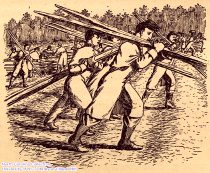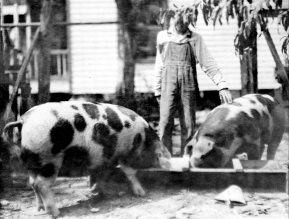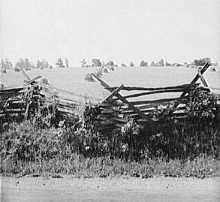The American Civil War: An Environmental View
Jack Temple Kirby, Miami University
©National Humanities Center |
|
(part 5 of 6)
A Poorer South, After All
Yet there is one more thing, more narrowly regional, about the war and a South changed forever. Here we return to farm fences
burned, and to farm animals, this time cattle and especially pigs. Soldiers of both sides tore down and burned uncountable southern farms' ubiquitous fences, usually for their cookfires and winter warming. Soldiers (both sides, again) also appropriated and consumed millions of southern meat animals, boiling or roasting beef and pork over fires fueled by torn-down fence wood. The collective picture is the beginning of the end of southern rural life as it had been known for at least two centuries.
Swine had been, with corn and other vegetables, not only the foundation of nutrition but of the independence of the southern yeomanry and poor, who had always been the great majority of the white population. Beginning in seventeenth-century Virginia, colonial legislatures had decreed that crop fields be securely fenced so that settlers might let great numbers of cattle and hogs range at large. The open range, a sensible accommodation to heavily forested eastern frontiers, permitted the rich and poor alike to accumulate subsistences and even wealth in animals that fattened for free. By the early nineteenth century, however, wealthy planters began to attack the range and its essential fencing laws as archaic: animals should be fenced instead of fields, they argued. Timbers for countless miles of fencing grew scarcer and expensive, range animals were more subject to disease epidemics, rural neighborhood peace was continually disrupted by disputes over broken fences and tramped crops. Edmund Ruffin and his friends proposed "reform" in Virginia during the 1830s, but their effort was promptly crushed. Virginia was, after all, a white-male democracy, and ordinary rural men understood that those with little or no land could hardly grow feed crops for confined animals. Fence reform would deprive them of their herds and reduce them to dependency. In the North, meanwhile, fencing reform succeeded and spread westward through the free states, so that by the time of the Civil War, the southern countryside was truly distinctive and, ironically, considering the prevalence of plantation slavery, a "democratic" countryside where even poor men (white, mostly) could feed their families and, as drovers and sellers of surplus beef and pork, participate in markets.
Thus the war destroyed not only thousands of miles of fences but consumed range cattle and hogs. In a subregion which I studied intensively for a longitudinal environmental history—seventeen counties in southeastern Virginia (below the James River) and adjacent northeastern North Carolina—there were nearly 360,000 hogs in 1860. According to the next federal census, in 1870, after five years of peace, there were still less than half that number. By 1880 the swine population had grown only about 60,000, but during the depressed '80s fell again. It rose substantially during the '90s, held steady during the first decade of the twentieth century, rose precipitously during World War I, then fell again and dramatically so, during the depressed 1920s. The postbellum high recorded in the 1920 census still did not equal the 1860s figure. Ordinary and poor southerners' hog heaven was gone forever.
Other scholars have demonstrated the Civil War's impact more generally. The open range was fatally crippled during 1861-1865—decades before fencing reform was finally successful—and the South was transformed from a self-sufficient surplus-shipping region into a region that imported fat Midwestern pork. Dependency in pork was a persisting burden of defeat in war, and there is more. Arguably southerners' nutrition deteriorated after the war, too. Range animals' meat is lean. Pork shipped south from Cincinnati came principally from new breeds such as the Poland China, an enormous porcine balloon on stick-legs, bred for fat. Southern consumers, suffering already from steadily declining cotton prices, became the Americans most likely to suffer heart diseases and strokes.
Library of Congress  |
Tennessee [?], 1907
|
"Instead, most ex-slaves fell into a dependency of an especially
onerous sort, sharecropping"
|
|
 |
At least as important is black southerners' disadvantage at the dawn of their freedom. Neither federal nor state governments offered
much material support to a people who began to negotiate free life and labor without property or education. There was no "Forty Acres and a Mule"—black folks' modest dream of reward during the war. Nor were there to be sufficient feral cattle and hogs in the woods and swamps, which might have provided the most basic sustenance and independence. Had the free range actually functioned as it had before the war, many black peasants might have taken up the economies poor white men had enjoyed already for two centuries; i.e., they might have claimed, bought, or inherited some pigs,
ranged them in the woods, fed themselves their own meat, traded for other food and necessities, and ultimately, perhaps, with expanded holdings sufficient to market surpluses for cash, purchased land. Instead, most ex-slaves fell into a dependency of an especially onerous sort, sharecropping, taking rations from landlords and merchants who bought Ohio meat by the barrel, falling into near-perpetual debt, and into the dubious celebrity, ultimately, of medical pathology. In the twentieth century, the South was known not only as the "Bible Belt" but the "Hypertension Belt." The postwar landscape, meanwhile, relentlessly reorganized, deforested, and cotton-spread, gradually closed out remnants of the open range and opportunity for poor people of any color. Fire, too, the ordinary farmers' means of creating crop fields, was finally criminalized in the early twentieth century. This reform, too, was as much a consequence of the Civil War, it seems to me, as the work of the brilliant new profession of forestry.
TeacherServe Home Page
National Humanities Center
7 Alexander Drive, P.O. Box 12256
Research Triangle Park, North Carolina 27709
Phone: (919) 549-0661 Fax: (919) 990-8535
Revised: July 2001
nationalhumanitiescenter.org |




